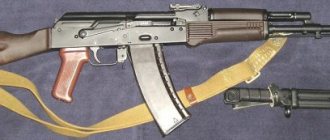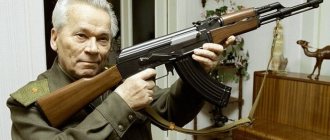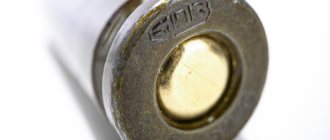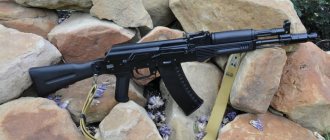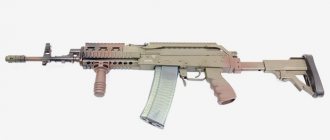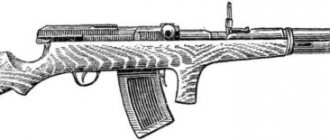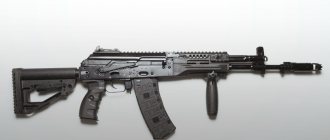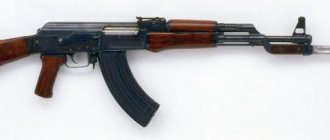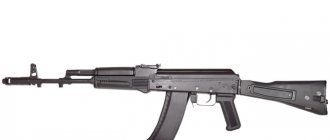History of the AK-47
The history of the birth of the Kalashnikov assault rifle began in 1943, when Soviet troops captured the first samples of German MKb.42(H) automatic carbines chambered for the intermediate cartridge 7.92x33 on the Volkhov Front. In the summer of 1943, at a meeting at the People's Commissariat of Defense based on the results of studying a captured machine gun and an American M1 carbine, it was decided that it was necessary to urgently develop their own set of weapons chambered for an intermediate cartridge, which would provide the infantry with the ability to effectively fire at ranges of about 400 meters, beyond the capabilities of existing pistols - machine guns. The development of the new complex began with the creation of a new cartridge, and already in November 1943, its drawings and specifications were sent to all organizations involved in the development of small arms. This cartridge, developed by designers Semin and Elizarov at OKB-44, had a bottle sleeve 41mm long and was loaded with a pointed bullet of 7.62mm caliber and weighing 8 grams with a lead core. The development of weapons for the new cartridge was started in several directions - a light machine gun, an assault rifle, a self-loading carbine and a carbine with manual reloading. In mid-1944, the testing commission selected for further development an automatic rifle designed by Sudaev, which received the designation AS-44. Based on the results of its refinement, a decision was made to produce a small series and conduct military tests, which took place in the spring and summer of 1945 both in a group of Soviet troops in Germany and in a number of units on the territory of the USSR. The overall test experience was positive, but the troops expressed a firm demand to reduce the weight of the machine gun. As a result, it was decided to conduct another round of tests at the beginning of 1946.
This is where Sergeant Kalashnikov comes onto the scene. After being wounded in 1942, during his treatment he developed a submachine gun of an original design, and as a result was sent to continue his service at the Scientific Testing Ground for Small Arms and Mortars (NIPSMVO) in the town of Shchurovo, not far from Moscow. Here Kalashnikov first developed a light machine gun chambered for a rifle cartridge (in 1943) and then a self-loading carbine chambered for a new intermediate cartridge (in 1945), the design of which was clearly influenced by the American M1 Garand rifle.
In November 1946, the Kalashnikov project, among some others, was approved for the production of prototypes, and the designer was sent to Kovrov to plant No. 2 for the direct production of prototype assault rifles. The first Kalashnikov assault rifle, known as the AK-46, had an automatic mechanism with a short-stroke gas piston located above the barrel and a Garandovsky-type rotating bolt. The machine also had a split-receiver design, and a separate safety and fire mode selector on the left side of the weapon. In December 1946, the Kalashnikov AK-46 assault rifle entered testing, where its main competitors were the Tula Bulkin AB-46 assault rifles and the Dementiev AD assault rifle. This was followed by a second round of testing, after which the AK-46 was declared unsuitable for further development by the commission. Despite this decision, Kalashnikov, with the support of a number of members of the test site commission, achieved a review of the decision and received approval for further development of his machine gun.
Returning to Kovrov, Kalashnikov decided to radically rework his design, in which he was actively assisted by the designer of the Kovrov plant, Zaitsev. As a result, for the next round of testing, a new machine gun was actually created, which had minimal resemblance to the AK-46. But it took into account as much as possible the comments and recommendations made to the previous sample from the test site’s testing commission.
As a result, three assault rifles were released for the next round of testing, carried out in December 1946 - January 1947 - slightly improved samples of Dementiev and Bulkin and, in fact, a new Kalashnikov assault rifle.
According to the test results, not a single model fully satisfied the tactical and technical requirements - the Kalashnikov assault rifle, being the most reliable of all three, showed insufficient firing accuracy, and the only assault rifle that fully satisfied the requirements for accuracy - the TKB-415 of the Bulkin system, had problems with reliability and survivability of a number of parts. At a meeting of the testing commission based on the results of the next stage of the competition, it was ultimately decided to recommend the Kalashnikov assault rifle for military testing as the most reliable, and bringing it to the requirements for accuracy of fire was postponed indefinitely. This decision can be considered justified from the point of view that in the situation that prevailed at that time, the Soviet army would have been much more useful in a reliable, but not very accurate machine gun in the near future than in a reliable and accurate machine gun unknown when.
It was decided to establish production of new assault rifles at a plant in Izhevsk, where Kalashnikov was sent from Kovrov at the end of 1947. The first batches of new assault rifles were assembled in Izhevsk in mid-1948, and at the end of 1949, based on the results of military tests, the new assault rifle was adopted by the Soviet Army in two versions under the designations “7.62mm Kalashnikov assault rifle AK” and “7.62mm Kalashnikov assault rifle with folding AKS butt" (for airborne troops).
Automatic model 1946
The Kalashnikov AK-46 assault rifle itself was a very crude and intermediate version.
It was rather a transitional model from the Shpagin submachine gun, the most common at that time in the Soviet (Red) Army, to the weapon that became familiar to everyone under the name AK-47.
It contained many shortcomings, but it was a necessary step towards the subsequent constructive breakthrough. Let's look at this weapon in more detail.
What was the circuit and device
Since the original machine gun was quite different from the model we are used to, it is interesting to know what the differences were:
- The cocking handle was located on the left, not on the right. The location was changed at the suggestion of the state commission, since when moving by crawling, the handle would rest against the stomach;
- Availability of a separate fuse;
- The lever for converting firing from single to burst firing was a separate device;
- Folding trigger mechanism on a pin.
The bolt frame with a rigidly fixed gas piston appeared during modifications at the Kovrov plant before the second round of the competition.
Its appearance dramatically improved the tactical and technical characteristics, so to the question of how the Kalashnikov assault rifle works, the answer is simple - due to the energy of the exhausted powder gases.
A similar device could have been copied from the Bulkin machine gun that participated in the competition.
The structure of the machine gun for burst firing was changed - the safety was combined with the transfer lever, which significantly simplified the design, making it clearer for soldiers.
What technical characteristics did the AK-46 have?
- Cartridge caliber 7.62×41 model 1943;
- Barrel length 450 millimeters;
- The total length of the machine is 950 millimeters;
- Magazine capacity of 30 rounds + 1 round in the barrel;
- The weight of the machine gun, excluding the weight of cartridges, is 4.328 kilograms;
- The target firing range is 0.8 kilometers.
What myths and misconceptions haunt the Kalashnikov assault rifle
The main myth regarding this type of weapon is the talk that this machine gun is the best on Earth. Essentially, on the planet, and even in Russia, there are many types of small arms that are superior in their characteristics to the Kalash; one can recall the same Abakan.
The second myth is that the machine gun was personally designed by Mikhail Timofeevich. In reality, the help of designer Zaitsev was simply invaluable; in addition, a whole group of designers also worked on the weapon. The work of German specialists led by Hugo Schmeisser cannot be ruled out.
Be that as it may, the Kalashnikov assault rifle was, is and will remain a legend glorifying Russian designers who created one of the most trouble-free assault rifles of the 20th century and, without a doubt, it is the most widespread.
Kalashnikov is still in service with a huge number of states. It is depicted on the coats of arms of 4 states and the flag of Mozambique. Yes, new weapons are coming, but it is unlikely that anyone else will achieve such mass distribution as the AK.
How the AK-47 and AKS were created
After the second round, held in 1946, the commission made a decision that stated that none of the machines submitted to the competition, even after modifications, met the required characteristics.
The machine gun created by designer Bulkin came closest to the necessary requirements in terms of tactical and technical characteristics (TTX). However, for reasons of simplicity and accessibility of production, and maybe for some other reasons, it was decided to modify the Kalashnikov assault rifle.
To bring the weapon to the required characteristics, the Kalashnikov-Zaitsev design team was sent to Izhevsk. At that time, a group of famous German designers worked at the Izhevsk arms factory.
Among them was the famous Hugo Schmeisser, who at one time designed many types of automatic and assault weapons. His weapons were successfully used by the Wehrmacht on various fronts of the Second World War.
It is unknown whether the Germans collaborated with the creators of the new machine gun, but it was very different from the one provided earlier.
The machine gun itself was originally produced with a wooden butt. However, for special troops this was inconvenient, primarily due to the length of the weapon, so a modification was created for them that reduced the dimensions of the product.
The wooden stock was replaced by a metal one, and the latter could be folded. This modification of the weapon was called the folding Kalashnikov assault rifle (AKS). It was possible to go into battle with this weapon straight after a parachute jump, without unfolding the butt.
What tactical and technical characteristics did the AK-47 have?
Let's consider the performance characteristics of the Kalashnikov assault rifle of the 1947 model. It should be noted here that the table itself is given for the basic model. The folding version is practically no different from it, with the exception of weight. It is 400 grams lighter and 2 millimeters shorter.
- The caliber of the weapon is 7.62 millimeters.
- The cartridge used for shooting is 7.62x39 mm;
- The total length of the machine is 870 millimeters;
- The length of the stem is 415 millimeters;
- The weight of the machine gun excluding cartridges is 4.3 kilograms;
- The total mass of cartridges is 576 grams;
- Total weight including cartridges - 4.876 kilograms;
- The maximum firing range is 0.8 kilometers;
- Rate of fire - 600 rounds per minute;
- Burst rate of fire - 400 rounds per minute;
- Rate of fire with single shots - from 90 to 100 rounds per minute;
- The initial bullet speed is 715 m/sec (2500 km/h);
- The number of cartridges in the magazine is 30 pieces.
How the 1974 AK-74 model came to be
In the early seventies of the last century, the armies of potential enemies (NATO) began to massively switch their automatic weapons from the usual rifle caliber to a lightweight unified cartridge with a caliber of 5.56 millimeters.
There was an urgent need for the armies of the Warsaw Pact countries and the Soviet Union to take a step in the same direction. The 5.45 mm caliber was called upon to replace the rifle cartridge.
It had sufficient destructive power, but was lighter in weight and less expensive to produce. The total weight of the eight wearable ammunition loads has been reduced by 1,400 grams.
The new version of the machine gun has a 100-meter longer direct shot range and a magazine made of durable plastic. Thanks to the new muzzle brake, the accuracy and accuracy of the combat has increased.
How did the modernized Kalashnikov assault rifle (AKM) appear?
In the early fifties, designer German Korobov presented a new model of infantry weapon, the TKB-517 assault rifle, to experts and army leadership.
This weapon had better accuracy and lighter weight compared to the AK-47. The mere fact that the production of TKB-517 was cheaper meant a lot. Taking into account the best technical and tactical characteristics of the newly introduced model, it was clear that the time had come for a new weapon.
However, the army leadership and the government of the Soviet Union decided not to radically change the production technology (as well as debunk the inflated glory of the designer) and gave Kalashnikov the opportunity to modernize his version of the weapon.
This is how the modernized AKM Kalashnikov assault rifle appeared.
In the new version, the butt was slightly raised compared to the original, which brought the butt resting point on the shoulder closer to the shot line. The target range was increased to one kilometer.
In addition, a light machine gun unified with it, called the RPK, was created on the basis of the AKM.
Is it possible to install a bayonet?
On the first AK-47 models, the installation of a bayonet was not provided. This fact indirectly proves the participation of German weapons designers in the work on weapons.
The fact is that during the Second World War, Nazi weapons did not have the possibility of attaching additional bladed weapons. The German infantryman had to be able to use weapons in such a way as to hit the enemy with a bullet.
Infantry soldiers were simply practically not trained in hand-to-hand combat techniques.
However, later the AK received a blade two hundred millimeters long, which was attached to the gas chamber. It had a double blade and fuller.
The appearance of the AKM also changed the design of additional weapons.
Instead of a double blade, a single blade appeared with a file on the other side.
The length of the blade was reduced to 150 millimeters. The bayonet-knife itself received more possibilities for use in the economic field for the needs of the soldier.
